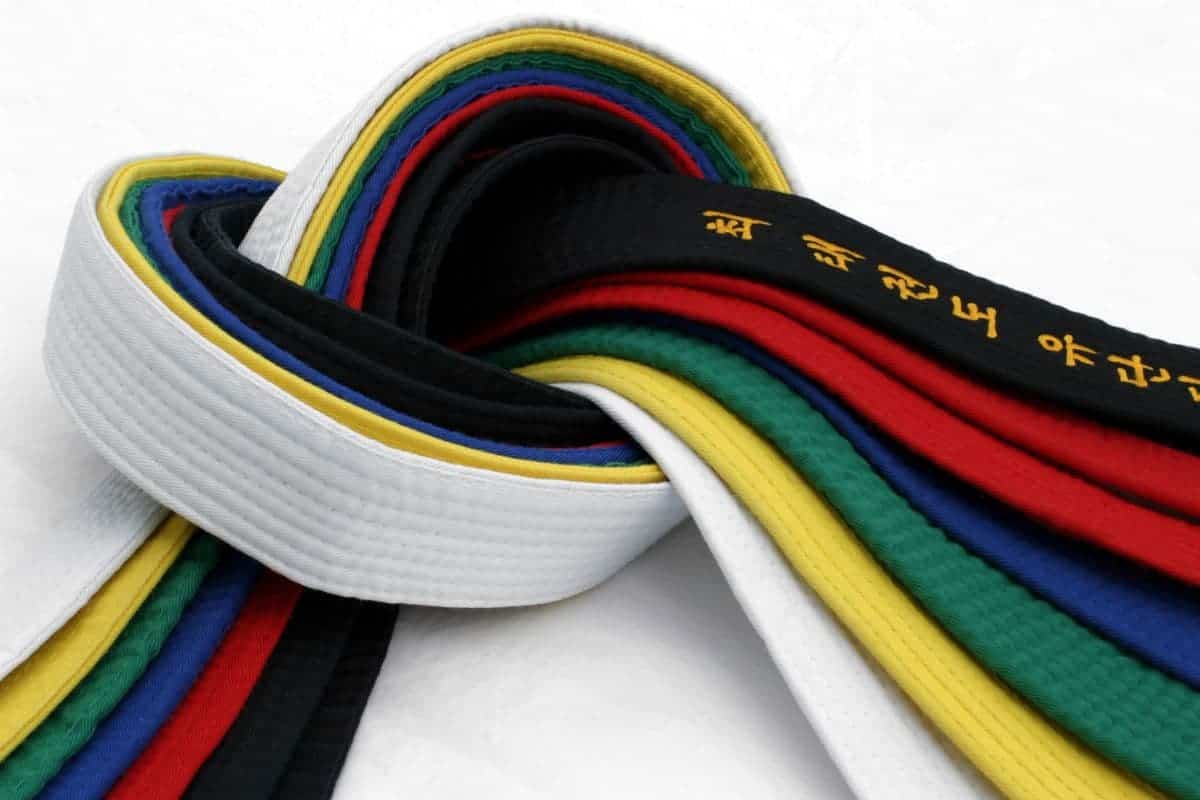If you do karate, you probably know that its standard uniform (or gi) consists of a jacket, pants, and a long belt. Looking at the belt, you might wonder why it’s so long.
Karate belts are long because they need to keep the jacket closed. Since fighters cannot have any metal fastenings, the belt must be long enough to tie securely around the body. These belts also evolved since the Heian period in Japan when long belts became fashionable.
In this article, we’ll explore the possible reasons karate belts are so long, how long your karate belt should be and a little bit about karate rankings as signified by your belt.
Table of Contents
Possible Reasons Karate Belts Are So Long
1. Karate Belts Don’t Come With a Fastener
Karate is a martial art that’s also a contact sport, meaning you’re likely fighting your opponent at close range.
Therefore, for safety reasons, karate uniforms cannot have any clips, buttons, or fastenings of any kind. If your opponent slides their face against any metal clips or objects on your body, it could cut them. That’s why karate uniforms are made of soft material throughout.
That also means a karate belt must be long enough to tie around your body without any additional adornments like buckles.
2. Longer Belts Won’t Come Untied As Easily
For any material to be tied securely, it needs to be long enough.
For example, shoelaces are long because you need to tie them such that they won’t come undone while you’re walking or playing sports.
Karate belts work the same way. They must stay securely fastened when you’re striking, using takedowns, or rolling on the ground. If they come untied, it can be a distraction at best (you’ll “expose” yourself to others) and a hazard at worst (your pants may fall down and cause you to trip on them).

3. Belts Keep the Gi Jacket Closed
Gi or keikogi is the Japanese term for most martial arts uniforms. It usually includes a jacket, pants, and a long belt. Confusingly enough, some martial arts (like kendo) only use the term “gi” to refer to the jacket. In karate, however, gi refers to the entire uniform.
In any case, the jacket or uwagi was likely fashioned after Japanese kimonos. These are T-shaped and don’t have any buttons, so they require an obi (belt or sash) to stay closed.
Therefore, it’s possible that (aside from the practical and safety reasons mentioned earlier) karate belts are long because the traditional clothes they were based on had long belts for keeping them closed as well. We’ll go into more detail on this later.
4. A Long Belt Looks Better With a Gi
To put it simply, a long belt just looks better.
While a shorter belt may be less noticeable, a long belt stands out. It helps divide the body at the waist, which is flattering for many body types.
Also, the way karate belts are tied adds a traditional element, which further emphasizes the martial art’s connection to pre-modern Japan (which we’ll get to in a bit).
In modern karate, belts also signify what rank you are. The longer the belt, the more you’ll notice its color.
Karate Belt Color Guide
Karate uses a color system for its belts to signify ranking. Since there are usually 9 ranks in karate, there are also 9 colors corresponding to each rank. Like many martial arts, karate uses white to designate the lowest rank and black to signify the highest.

The rankings are represented from lowest to highest below:
- White
- Yellow
- Orange
- Green
- Blue
- Purple
- Brown
- Red
- Black
It can take at least 5 years to go from a white belt to a black belt, depending on factors such as your skill level, experience, and how hard and often you train.
5. Belts Have a Long History in Japan
During the Heian period (794-1185), it was fashionable to tie kimonos with an obi. Almost five centuries later during the Edo period (1603-1867), the obi became a bit narrower. It changed in length and width over time, but its fundamentals (aesthetics and function) more or less remained the same.
It’s thought that the judo teacher Jigoro Kano introduced the gi into martial arts in the late 1800s. Since the kimono (with its characteristic T-shaped jacket and wide-leg pants) was standard during this time, the judo gi was likely patterned after the kimono style — albeit modified to withstand the strenuous movements judo required.
Originally, karate was performed in regular clothing. It wasn’t until the 1920s that Gichin Funakoshi introduced the gi to karate. He likely modeled the karate gi after the judo uniform Kano created.
In modern times, the kimono and obi are hardly used as everyday wear in Japan, especially in urban areas. However, they still retain their historical significance and are used for formal or traditional events.
How Long Should Your Karate Belt Be?
Belts in martial arts like karate tend to be longer than normal belts for all the reasons we’ve outlined above. But how long should they be, exactly?
To determine your karate belt length, use a measuring tape to measure around your waist. Do this while wearing the gi, as the bulk of the jacket can add a few more inches. Take that number and multiply it by 3.
The result of the above is roughly equivalent to the belt length you need. Karate belt sizes usually run from 00-8.
For example, Amazon’s AAMA Plain Color Belt for Martial Arts offers a selection of karate belts in multiple sizes and colors. It also comes with a handy sizing guide to tell you what size you need based on waist measurements. This belt is good not only for karate, but also for aikido, taekwondo, and judo.
Conclusion
The karate uniform (which includes the belt) has been popular since the 1920s.
While there’s no clear-cut reason why karate belts are so long, it’s likely for fashionable, historical, and functional reasons. For example, your gi looks better with a belt, and it also keeps your uniform from coming undone and causing safety hazards (not to mention embarrassment).

